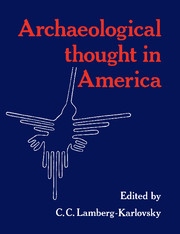Book contents
- Frontmatter
- Contents
- List of illustrations
- Introduction
- Part I History, method, and theory
- 1 History and contemporary American archaeology: a critical analysis
- 2 Aspects of the application of evolutionary theory in archaeology
- 3 The “New Archaeology,” then and now
- 4 Marxism in American archaeology
- 5 Formal approaches in archaeology
- 6 Ideology and evolutionism in American archaeology: looking beyond the economic base
- 7 The present and the future of hunter-gatherer studies
- 8 Paleopathology and the interpretation of economic change in prehistory
- Part II Archaeology in the Americas and beyond
- References
- Index
2 - Aspects of the application of evolutionary theory in archaeology
Published online by Cambridge University Press: 06 July 2010
- Frontmatter
- Contents
- List of illustrations
- Introduction
- Part I History, method, and theory
- 1 History and contemporary American archaeology: a critical analysis
- 2 Aspects of the application of evolutionary theory in archaeology
- 3 The “New Archaeology,” then and now
- 4 Marxism in American archaeology
- 5 Formal approaches in archaeology
- 6 Ideology and evolutionism in American archaeology: looking beyond the economic base
- 7 The present and the future of hunter-gatherer studies
- 8 Paleopathology and the interpretation of economic change in prehistory
- Part II Archaeology in the Americas and beyond
- References
- Index
Summary
Setting aside the general developmental idea with which the term evolution is associated in English, there are two distinctly different explanatory systems that bear this label and that are current in American archaeology. One, of course, is the methodology initiated by Darwin (1859) in the mid-nineteenth century, linked to genetics in the mid-twentieth century (e.g. Fisher 1930; Haldane 1932), and which today constitutes the foundation for the scientific understanding of the organic world and its diversity. The second explanatory system called evolution is more commonly identified as cultural evolution. Although it is frequently conceived as the application of principles of biological evolution to cultural phenomena (e.g. Yoffee 1979), even cursory examination demonstrates that it is a fundamentally different methodology (Blute 1979; Dunnell 1980). Cultural evolution, as a system of explanation, is far more ancient than biological evolution. Its rigorous expression as a “theory” is usually traced to Spencer (e.g. 1857), at about the same time as Darwin was forwarding his methodology. As was also true of biological evolution, cultural evolution fell from favor in academic circles in the early twentieth century, not to be revived until midcentury largely by the work of White (1949). White (1959b) plainly recognized that his position was at variance with evolution in the natural sciences as did many other early workers (e.g. Carneiro 1967; Sahlins and Service 1960). This revival of Spencerian evolution was initially limited to sociocultural anthropology; archaeologists found little of value in it at first (Willey 1961).
- Type
- Chapter
- Information
- Archaeological Thought in America , pp. 35 - 49Publisher: Cambridge University PressPrint publication year: 1989
- 71
- Cited by



